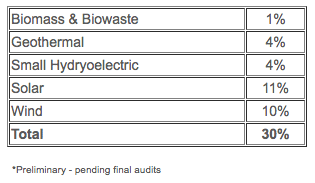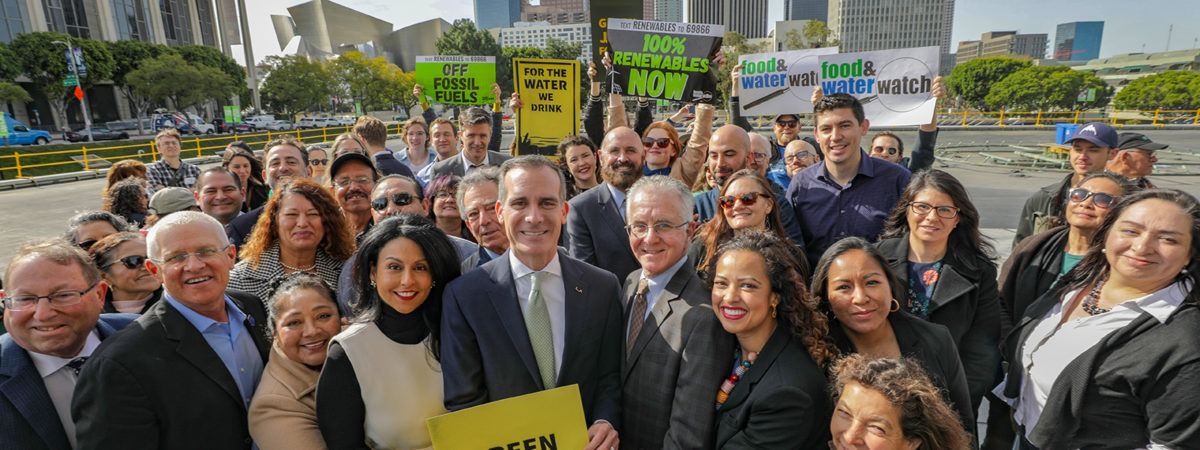Eric Garcetti is positioning Los Angeles to be a leader, even within California. This morning the Los Angeles mayor announced that the city’s municipal utility – the largest in the nation – would phase out two enormous gas plants and one smaller one by 2029. These three together represent 38% of the utility’s gas-fired generation.
This was positioned as part of the city’s move to 100% renewable energy, with Mayor Garcetti invoking the concept of the “Green New Deal” – the latest evidence that this policy proposal will see more action in the next two years at the state and local level than the federal level.
BREAKING: Mayor Eric Garcetti says Los Angeles won't go through with a plan to invest billions of dollars in gas-fired power plants, which contribute to climate change and local air pollution.
“This is the Green New Deal," Garcetti told me this afternoon. https://t.co/K5X2nNzGe7
— Sammy Roth (@Sammy_Roth) February 12, 2019
According to U.S. Department of Energy data, the Scattergood, Haynes and Harbor plants currently represent over 2 GW of operational capacity, and this brings up the big question of what these plants will be replaced with.
Getting to 100%
LADWP has a target to reach carbon neutrality by 2050 – five years after the state’s mandate for investor-owned utilities. But whether the target is 2045 or 2050, getting there will involve planning.
As part of the announcement, Garcetti has ordered LADWP to “shift focus” from its Strategic Long Term Resource Plan to a 100% renewable energy study that LADWP is undertaking with the U.S. Department of Energy’s Natural Renewable Energy Laboratory (NREL).
“That’s huge,” according to Bernadette Del Chiaro, the executive director of California Solar and Storage Association. She says that both taking this capacity off-line and prioritizing the NREL study will force LADWP to plan for a more rapid decarbonization of electricity.

LADWP did not respond to pv magazine request for comments by press time as to whether or not the new retirements will affect its current trajectory to reach 55% renewable energy in 2030 – 5% below the state’s mandate for investor-owned utilities (IOUs). LADWP was already supplying around 30% of its electricity from renewable energy sources in 2017, but this is again less than the state’s big IOUs.
A need for DG solar + storage
However, the raw portion of renewable energy is not the only big question behind the announcement. Another is what resources will fill the gap in generation. LADWP has traditionally imported much its electricity from outside its service area, but there is more to meeting reliability than kilowatt-hours. The utility must also meet local reliability requirements, which includes the supply of ancillary services.
And LADWP may not be able to do that solely by increasing its imports, and CALSSA’s Del Chiaro notes that the plants in the Los Angeles basin are currently supplying voltage support. Renewable energy sources including distributed solar and storage can supply these essential grid services using advanced inverter technology, and Clean Coalition has told pv magazine staff that voltage support using reactive power is better supplied via distributed resources than centralized generation.
Del Chiaro says that LADWP will need to continue meet its needs using a combination of local and imported resources – which will mean local distributed generation.
Los Angeles leads the nation in raw volume of solar, but according to Del Chiaro the per-capita portion of rooftop solar isn’t as high as in other cities like San Diego. This isn’t for lack of available roofs, and unlike other utilities Los Angeles has kept its basic retail-rate net metering. Instead, Del Chiaro says that bureaucracy is to blame.
“I can’t tell you how many contractors refuse to do business in Los Angeles because of the bureaucracy,” Del Chiaro told pv magazine. She notes that while the residential interconnection process has finally been streamlined after a long struggle, that commercial and industrial interconnection remains a slog, and that now installers are seeing the same problems trying to get energy storage systems interconnected.
“The behind-the-meter market is not where it needs to be,” laments Del Chiaro. And she notes that changes will be necessary if the city is to move forward with its plans. “We could do it much more quickly if we could harness the behind-the-meter market.”
Del Chiaro is hopeful that Garcetti’s move will spur action at LADWP. However, she notes that there is more to getting to high levels of renewable energy than just setting targets. “Everybody has been binge-eating on big ideas and nobody has been getting up early to do the hard work of actually building the market,” she says.
This content is protected by copyright and may not be reused. If you want to cooperate with us and would like to reuse some of our content, please contact: editors@pv-magazine.com.









By submitting this form you agree to pv magazine using your data for the purposes of publishing your comment.
Your personal data will only be disclosed or otherwise transmitted to third parties for the purposes of spam filtering or if this is necessary for technical maintenance of the website. Any other transfer to third parties will not take place unless this is justified on the basis of applicable data protection regulations or if pv magazine is legally obliged to do so.
You may revoke this consent at any time with effect for the future, in which case your personal data will be deleted immediately. Otherwise, your data will be deleted if pv magazine has processed your request or the purpose of data storage is fulfilled.
Further information on data privacy can be found in our Data Protection Policy.